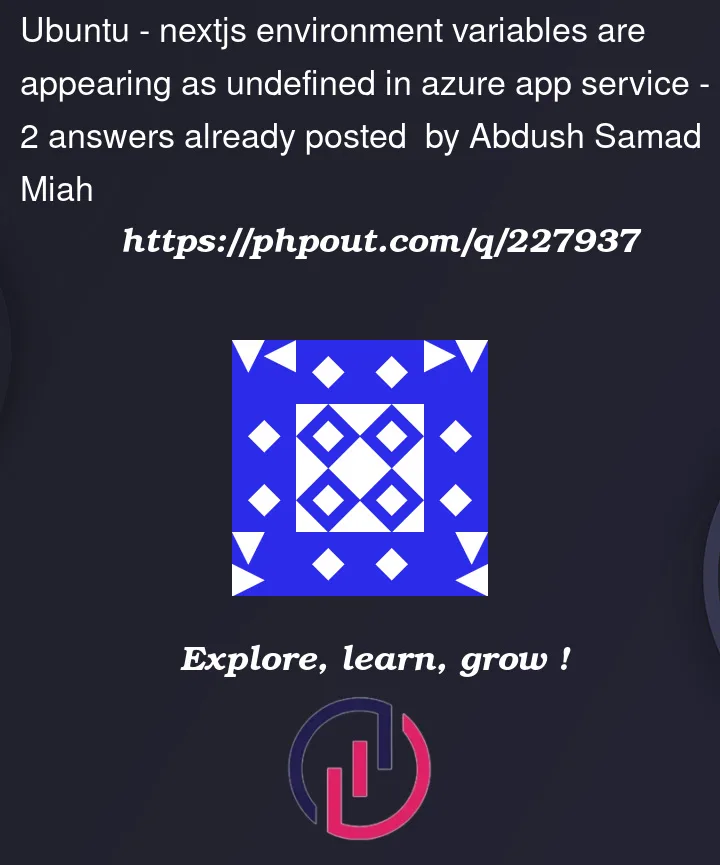I’ve seen all similar answers and none of the solutions seems to work for me.
I am deploying my solution using github actions workflow, here is what my yaml code looks like:
name: Build and deploy x platofrm - UAT
on:
push:
branches:
- master
workflow_dispatch:
jobs:
build:
runs-on: ubuntu-latest
steps:
- uses: actions/checkout@v2
- name: Set up Node.js version
uses: actions/setup-node@v1
with:
node-version: '18.x'
- name: npm install, build, and test
run: |
npm install
npm run build --if-present
npm run test --if-present
- name: Set Environment Variables
run: |
echo "NEXT_PUBLIC_API_URL=${{ vars.NEXT_PUBLIC_API_URL }}" > .env.production
echo "NEXT_PUBLIC_PYTHON_API_URL=${{ vars.NEXT_PUBLIC_PYTHON_API_URL }}" >> .env.production
echo "NEXTAUTH_SECRET=${{ secrets.NEXTAUTH_SECRET }}" >> .env.production
- name: Zip artifact for deployment
run: zip -r release.zip .
- name: Upload artifact for deployment job
uses: actions/upload-artifact@v2
with:
name: node-app
path: release.zip
deploy:
runs-on: ubuntu-latest
needs: build
environment:
name: 'Production'
url: ${{ steps.deploy-to-webapp.outputs.webapp-url }}
steps:
- name: Download artifact from build job
uses: actions/download-artifact@v2
with:
name: node-app
- name: Unzip artifact for deployment
run: unzip -o release.zip
- name: 'Deploy to Azure Web App'
id: deploy-to-webapp
uses: azure/webapps-deploy@v2
with:
app-name: 'x-platform-uat'
slot-name: 'Production'
publish-profile: ${{ secrets.AZUREAPPSERVICE_PUBLISHPROFILE_DFE186FC1DA249E4A244CC61460052A6 }}
package: release.zip
The build and deploy pipelines work absolutely fine.
I read in several articles that you cannot read from the App Settings/Configuration Settings within the webapp and so I am manually creating the .env file and injecting into it.
FYI I have also tried different variants of .env.local .env.production.local .env.development.local etc etc in fact my actual pipeline creates all these variations which I’ve removed for brevity of code.
I’ve read the documentation:
https://nextjs.org/docs/pages/building-your-application/configuring/environment-variables#loading-environment-variables
and can confirm that I have constructed my .env file like so:
NEXT_PUBLIC_API_URL=https://something.api
but when I do:
console.log(process.env['NEXT_PUBLIC_API_URL']);
or
console.log(process.env.NEXT_PUBLIC_API_URL);
Neither work.
I have even gone to extent of installing:
dotenv
then ensuring this exists in the next.config.js file like so:
require('dotenv').config();
But still no luck!
Any help appreciated!!!




2
Answers
My issue was that I was writing to the .env files after I run the build, I flipped them around so that I wrote to the .env file first then ran npm run build as below:
This then allowed me to do the following in my code which was successfully reading from the .env file:
The reason the order is important is because the npm run build command generates a production-ready build of your Next.js application in a folder, typically named out or build.
After the build step, you're creating a zip file named release.zip that contains the build artifacts. So I was effectively creating a non existent file because it was created after the npm build command. Took a full day of mine, hope this can help someone!
It’s pretty common … You can actually read from Application Settings or Connection Strings from App Service Configuration.
This might help you out: https://stackoverflow.com/a/68189283/12944326 & this https://nextjs.org/docs/app/api-reference/next-config-js/env
Use next.config.js to declare env vars to be available for the client-side.
Hopefully this will help you out !